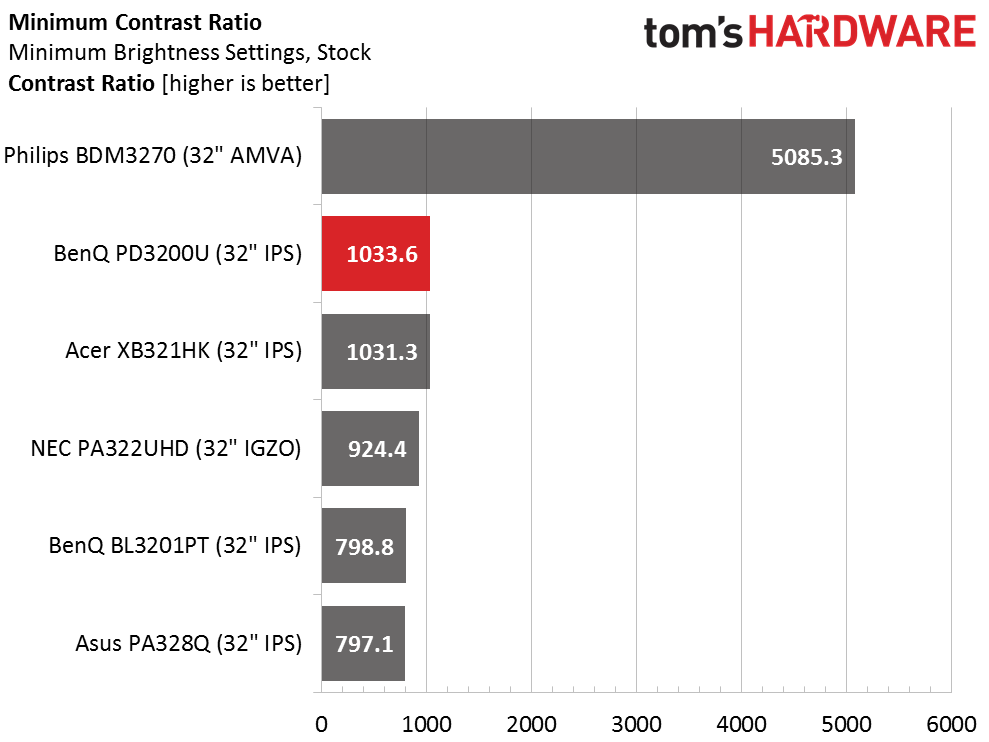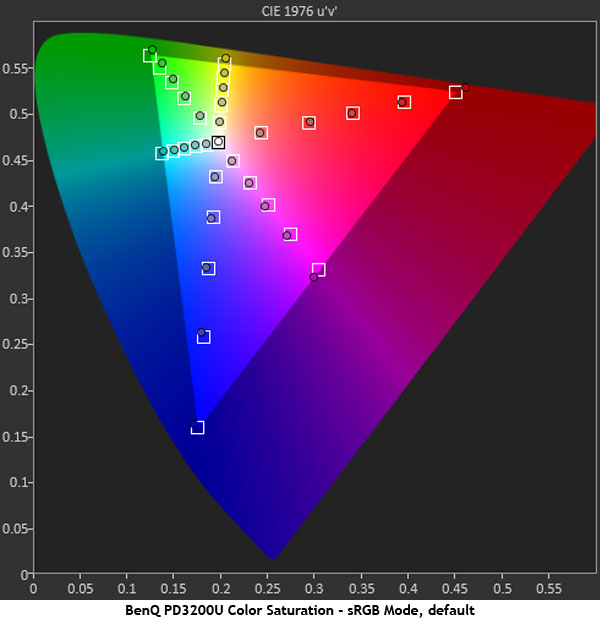BenQ PD3200U 32" Ultra HD Monitor Review
Why you can trust Tom's Hardware
Grayscale, Gamma & Color
For this review, we measured the PD3200U’s Standard (default), sRGB, and User modes; the User mode allows for a full calibration. We quickly discovered, at least in the case of our sample, that there were no gains to be had. Our recommendation is to use the monitor in its default state and simply set your preferred brightness.
Grayscale Tracking
Our grayscale and gamma tests are described in detail here.



The first chart represents the PD3200U as shipped. We didn’t even change the brightness slider before taking the measurement series. You can see that grayscale tracking is pretty much perfect. In fact, the sweet spot from 30-80% brightness has errors under .3dE. That’s not much greater than the tolerance level of our i1 Pro. There aren’t many professional screens that can match this performance after calibration.
sRGB offers much the same result with visually perfect tracking from bottom to top. If you engage the User mode, its Normal color temp also offers perfection. If you want to try the User Define preset, it starts off quite green, so you must adjust the RGB sliders. Even with care, there are no gains to be had. Our best result was .89dE, which would be great on any other monitor, but not one that measures .37dE out of the box.
Comparisons


Surprisingly, the PD3200U does not take the crown for out-of-box grayscale tracking accuracy. That win still belongs to the Philips BDM3270 we reviewed recently. We’ve only seen a handful of monitors in the past four years that can perform at this level. It’s amazing to have two of them come through the lab in such short succession.
Gamma Response



We’ve had a few monitors in the lab that aced the grayscale test but didn’t do as well on the gamma benchmark. The PD3200U is not on that list. You can see from the traces that its luminance curve is perfect in both the default Standard mode and User post-calibration. sRGB shows a small dip at 10% which equates to a small .9cd/m2 error—barely visible. In fact, it’ll probably improve shadow detail a bit in dark content.
Comparisons


The PD3200U’s gamma values stay within a tight .08 range. It doesn’t really get any better. With an average value of 2.17, the trace runs a tad light, but the error is invisible. With tracking like this, color saturation and luminance should be superb.
Get Tom's Hardware's best news and in-depth reviews, straight to your inbox.
Color Gamut & Luminance
For details on our color gamut testing and volume calculations, please click here.






With great grayscale and gamma results already in the books, we expected perfect color and weren’t disappointed. Once again, the Standard mode is the go-to preset with ideal saturation and luminance tracking. There is a slight over-saturation in red, and magenta’s hue is off by a hair, but visually there are no errors. Luminance also shows an excellent balance with all colors near the neutral line. sRGB actually hits a few more targets with even better luminance measurements, but the difference can’t be seen with the naked eye. Calibration doesn’t make much impact at all and in fact returns a slightly higher error value. Visually, there is no way anyone will be able to discern between the three picture modes.
Comparisons


1.11dE represents the default Standard mode. sRGB measures an equally excellent 1.21dE, while calibration of the User mode offers gamut accuracy of 1.31dE. The results are essentially a wash, but again, we recommend leaving the PD3200U’s image adjustments alone and simply setting brightness to your preferred level. Remember that the top finishing PA322UHD’s number is a calibrated result.
Thanks to a little bonus red, sRGB gamut volume works out to a little over 105%. Those engaged in color-critical work will want to create a custom profile, which is a good idea for any monitor regardless of price or accuracy level.
Current page: Grayscale, Gamma & Color
Prev Page Brightness & Contrast Next Page Viewing Angles, Uniformity, Response & Lag
Christian Eberle is a Contributing Editor for Tom's Hardware US. He's a veteran reviewer of A/V equipment, specializing in monitors. Christian began his obsession with tech when he built his first PC in 1991, a 286 running DOS 3.0 at a blazing 12MHz. In 2006, he undertook training from the Imaging Science Foundation in video calibration and testing and thus started a passion for precise imaging that persists to this day. He is also a professional musician with a degree from the New England Conservatory as a classical bassoonist which he used to good effect as a performer with the West Point Army Band from 1987 to 2013. He enjoys watching movies and listening to high-end audio in his custom-built home theater and can be seen riding trails near his home on a race-ready ICE VTX recumbent trike. Christian enjoys the endless summer in Florida where he lives with his wife and Chihuahua and plays with orchestras around the state.
-
sparkyman215 Wow these last two monitors you've reviewed have been killer. Where was that NEC during the tests, huh ;)Reply -
Larsenexx44 I am looking at something in this screen size as UHD. Can you game on this monitor, say Far Cry 3 or Ashes of the singularity?Reply -
Realist9 Still waiting on a 32" or greater 4k monitor with g-sync and >60hz. I guess I should stop holding my breath.Reply -
Realist9 Reply19496250 said:4K at more than 60Hz requires DP1.3 or better. HDMI simply can't.
So? 1080's have DP 1.4. They have been out for almost a year, and I would think monitor vendors knew well in advance that they, and more cards with that, would be coming. So they would have had, what, 2 yrs? That's not enough?
I think the more likely cause is that monitor vendors know that it will be a while before MANY people will be able to use and want 4k at >60Hz. And they just don't think they can make $$ releasing one anytime soon.
Since the visual difference between 1080 and 1440, IMO, is not enough to warrant an upgrade, I'm stuck waiting for this "may never get here" monitor. First world problems I guess.
-
Jung I wanted to wait for 4K GSYNC >60Hz, but seems like those things aren't coming together soon, so I popped for the Acer Predator XB321HK... 2 out of three ain't bad.Reply -
VincentP Spec table in the introduction lists the panel type as AMVA (a type of vertical alignment panel). This isn't correct.Reply
BenQ lists the panel type as IPS, and this is how it is listed in performance results in this article.
The article also mentions AHVA, which is possible since this is an IPS type technology (unlike AMVA). -
JackNaylorPE Reply19497321 said:I wanted to wait for 4K GSYNC >60Hz, but seems like those things aren't coming together soon, so I popped for the Acer Predator XB321HK... 2 out of three ain't bad.
I think the more likely cause is that monitor vendors know that it will be a while before MANY people will be able to use and want 4k at >60Hz. And they just don't think they can make $$ releasing one anytime soon.
Since the visual difference between 1080 and 1440, IMO, is not enough to warrant an upgrade, I'm stuck waiting for this "may never get here" monitor. First world problems I guess.
The Asus ROG PG27UQ and the Acer Predator XB272-HDR are slated to arrive in Q2 2017, that starts tomorrow (and no, not an April Fool's joke) . That puts it some time in the next 90 days though I expect we will see them released right around the big outer shows in May.
AU Optronics AH-IPS panel, w/ 3840 x 2160 native resolution and 144Hz
Dynamic Range Support via HDR10
384-zone backlighting system
Enhance color palette via Quantum Dot filter
1000 nits of brightness (3x that of the monitor in the review)
DisplayPort 1.4 connector
HDMI 2.0a display controller (60 Hz only)
AHVA IPS Panel
And with AIB 1080 Ti's dropping this month, you will actually have something to drive it, tho it will take two of them to really make the monitor shine. Only question that as yet hasn't been answered, at least I haven't found it, is confirming ULMB support. It has G-Sync and ULMB comes with that ... in the past was no ULMB at 4k cause DP 1.2 couldn't support the high refresh rates needed for it. -
Novell SysOp fire phasers 5 time Now review the BenQ BL2711U. You can't do their 32" and neglect their 27". I don't buy the BS that 4K is better on a 32, and the 27 has 167ppi.Reply